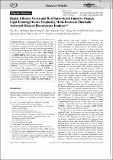Highly efficient green and red narrowband emissive organic light-emitting diodes employing multi-resonant thermally activated delayed fluorescence emitters
Date
23/12/2022Author
Grant ID
NF171163
ep/l017008/1
EP/P010482/1
SRF\R1\201089
RPG-2016-047
Keywords
Metadata
Show full item recordAbstract
Herein, we demonstrate how judicious selection of donor decorating a central multi-resonant thermally activated delayed fluorescence (MR-TADF) core based on DiKTa can lead to very high-performance OLEDs. Decorating the DiKTa core with triphenylamine (TPA) and diphenylamine (DPA), 3TPA-DiKTa and 3DPA-DiKTa exhibit bright, narrowband green and red emission in doped films, respectively. The OLEDs based on these emitters showed record-high performance with maximum external quantum efficiencies (EQEmax) for this family of emitters, with a EQEmax of 30.8% for 3TPA-DiKTa at λEL of 551 nm and 16.7% for 3DPA-DiKTa at λEL of 613 nm. The efficiency roll-off in the OLEDs was improved significantly by using 4CzIPN as an assistant dopant in hyperfluorescence (HF) devices. The outstanding device performance has been attributed to preferential horizontal orientation of the transition dipole moments of 3TPA-DiKTa and 3DPA-DiKTa.
Citation
Wu , S , Gupta , A K , Yoshida , K , Gong , J , Hall , D , Cordes , D B , Slawin , A M Z , Samuel , I D W & Zysman-Colman , E 2022 , ' Highly efficient green and red narrowband emissive organic light-emitting diodes employing multi-resonant thermally activated delayed fluorescence emitters ' , Angewandte Chemie International Edition , vol. 61 , no. 52 , e202213697 . https://doi.org/10.1002/anie.202213697
Publication
Angewandte Chemie International Edition
Status
Peer reviewed
ISSN
1433-7851Type
Journal article
Description
Funding: S. W. thanks the China Scholarship Council (201906250199). A. K. G. is grateful to the Royal Society for Newton International Fellowship NF171163. EZ-C and IDWS acknowledge support from EPSRC (EP/L017008, EP/P010482/1). We are also grateful for financial support from the University of St Andrews Restarting Research Funding Scheme (SARRF) which is funded through the Scottish Funding Council grant reference SFC/AN/08/020. EZ-C is a Royal Society Leverhulme Trust Senior Research fellow (SRF\R1\201089). We would also like to thank the Leverhulme Trust (RPG-2016-047) for financial support.Collections
Items in the St Andrews Research Repository are protected by copyright, with all rights reserved, unless otherwise indicated.

